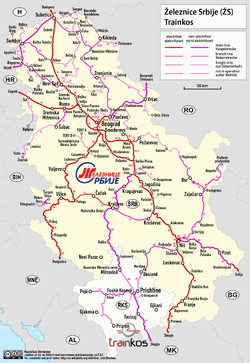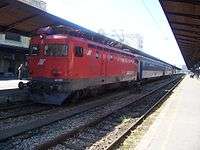Serbian Railways
Serbian Railways (Serbian: Железнице Србије / Železnice Srbije; abbr. ŽS / ЖС) is a Serbian engineering and technical consulting company based in Belgrade, Serbia. Serbian Railways is an affiliated member of the International Union of Railways (UIC).
In August 2015, the Government of Serbia established three new companies which took over Serbian Railways former jurisdictions - Srbija Voz (passenger transport), Srbija Kargo (cargo transport) and Serbian Railways Infrastructure (infrastructure management). Since then, Serbian Railways continued with modified business activity: engineering activities and technical consulting, consultancy activities for various fields and management of real estate.[5]
History

The history of rail transport in Serbia began in the mid-19th century when most of the territory was still held by the Austro-Hungarian and Ottoman Empires. The first rail line on the present-day territory of Serbia was inaugurated on 20 August 1854, between Lisava-Oravica-Bazijaš and the train operated on horse-drawn traffic which were replaced in 1856 by steam locomotives. Part of the line is located in Serbia passing through Bela Crkva while the rest is in Romania. All subsequently built lines were laid towards Budapest as the territory was still part of the Austro-Hungarian Empire back then. On the territory which was under the Ottomans, the line Skopje-Kosovska Mitrovica was inaugurated in 1874. However, the major expansion began after the Berlin Congress and the independence of the, theretofore vassal to the Ottomans, Principality of Serbia during the second half of the 19th century.[6]
Serbian Railways as a company is traced back to 1881 when Prince Milan I declared formation of the Serbian National Railways. The first train departed from Belgrade to Niš on 23 August 1884, which is considered by Serbian Railways as the official year when the company was created.
This was not the first operational railway on the territory of then-Kingdom of Serbia, though, as the one in opened in 1882, a primarily industrial, though occasionally used for passenger transport, 12 km long 600 mm wide gauge track from Majdanpek copper processing plant to Velike Livade (a former village taken over by the plant) and constructed by the Serbian Copper & Iron Co. (official name in English, most stock holders were British) had its first run on the track in June 1882.[7]
Another one in Eastern Serbia followed suit in 1888, the 82 km long dual purpose (industrial and passenger transport) 760 mm gauge track from Vrška Čuka mine to the port of Radujevac on the Danube, built by the Societé Anonyme "L'Industrielle Serbe" registered at Brussels in Belgian, French, (Austro-)Hungarian, and Serbian ownership (in order of the percentage of stock owned).[8][9]
From the 1920s until the 1990s it operated under the name Yugoslav Railways, responsible for railways in all Yugoslavia. The first electrified line was opened between Belgrade and Šid in 1970. Line connecting Serbia with south Adriatic (Belgrade-Bar) was opened in 1976.
1990s–2010s
During the 1990s, following dissolution of Yugoslavia, railways in Serbia suffered the lack of maintenance of infrastructure and the level of traffic (especially cargo) decreased dramatically. As of 2000, Serbian Railways had a total of 32,832 employees.
The negative trend continued well into the 2000s and began reversing since the beginning of 2010s when program of modernization both of infrastructure and rolling stock have begun.
In 2013, Serbian Railways signed a contract with RZD International, worth $840 million, aimed at modernization of ageing infrastructure by focusing on improving key sections of main railway lines. Section between Ruma and Golubinci on Belgrade-Šid line was reconstructed in 2014 and additional five sections on Belgrade-Niš-Preševo line (Sopot-Kosmajski Kovačevac, Mala Krsna-Velika Plana, Vinarce-Đorđevo, Vranjska Banja-Ristovac, and Bujanovac-Bukarevac) were modernized and revitalized in 2015 and 2016, while section between Belgrade and Pančevo on Belgrade-Vršac line saw doubling tracks besides reconstruction.[10]
2015–present
In March 2015, the Government of Serbia announced its plan to establish three new railway companies, splitting the Serbian Railways in separate businesses - cargo, passenger and infrastructure.[11]
These three companies, fully separated and independent from the Serbian Railways - Srbija Voz, Srbija Kargo and Serbian Railways Infrastructure were founded on 10 August 2015, in the process of reconstruction and better optimization of business.[5] In the process, around 6,000 employees should leave the company with severance payments (amounting to 39 million euros) by the end of 2017, thus way cutting total number of employees from 17,635 in 2016 to around 11,500 in 2018, in all four companies combined.[12] From 2018 to 2020, in third wave of dismissals, another 1,500 employees are planned to leave the company, cutting the total number of employees to around 10,000 by 2020.[13] That would be 7,635 less employees (43.29%) than in 2016, and 22,800 less (69.51%) than in 2000.[13]
- Current modernization projects
In 2015, the Government of Serbia signed memorandum with Government of China on reconstruction and thorough modernisation of Belgrade-Subotica line by bringing it to high-speed line standard. It is part of planned high-speed railway link between Belgrade and Budapest in Hungary, billed as a hallmark scheme under Belt and Road Initiative championed by China. Works on section between Belgrade and Stara Pazova are set to start in 2017, while works on section between Novi Sad and Subotica are to commence in 2018.[14]
In 2017, as part of the contract with RZD, began reconstruction of Belgrade-Novi Sad-Subotica line on section between Stara Pazova and Novi Sad and Belgrade-Bar line on section between Resnik (on outskirts of Belgrade) and Valjevo.[15][16]
New investments in rolling stock took place in last couple of years. Some 60 new passenger trains (39 diesel multiple units RA2 from the Russian company Metrovagonmash and 21 electric multiple units FLIRT3 from Swiss company Stadler) were ordered and are now in service.[17][18] Because of this, the passenger ridership has risen on the services operated by the new trains.
Rolling stock
- Electric locomotives
- Diesel locomotives
- Electric trainsets
- Diesel trainsets
- ŽS 711 (39 units in total, 39 in service)
- Passenger car park
- Passenger cars - "open" or "compartment" (364 units)
- Sleeping cars (52 units)
- Couchette cars (63 units)
- Dining/lounge cars (15 units)
Railway network
The Serbian railway system consists of 3,739 km of rails of which 295 km is double track (7.9% of the network). Some 1,279 km of track (33.6% of the network) is electrified.[4] Serbia has rail links with all of adjacent countries, except Albania.
Railroads are categorized as "main lines", "regional lines", "local lines" or "manipulative lines". Following is the table of main lines in Serbia:
| Designation | Route | Length | Tracks | Electrification | Notes |
|---|---|---|---|---|---|
| Belgrade - Ruma - Border with Croatia near Šid | shared track between Belgrade and Stara Pazova with Railway line 4 | ||||
| Belgrade - Niš - Border with Macedonia near Preševo | two tracks between Velika Plana and Stalać as well as between Đunis and Niš | ||||
| Belgrade - Mala Krsna - Velika Plana | |||||
| Belgrade - Novi Sad - Border with Hungary near Subotica | shared track between Belgrade and Stara Pazova with Railway line 1; two tracks between Belgrade and Stara Pazova | ||||
| Niš - Border with Bulgaria near Dimitrovgrad | planned electrification | ||||
| Belgrade - Pančevo - Border with Romania near Vršac | 2 tracks and electrified between Belgrade and Pančevo | ||||
| Belgrade - Valjevo - Užice - Border with Montenegro near Prijepolje | |||||
| Lapovo - Kragujevac - Kraljevo - Boundary line with Kosovo near Rudnica | |||||
| Subotica - Sombor - Border with Croatia near Bogojevo |
See also
References
- 1 2 "КОНСОЛИДОВАНИ БИЛАНС УСПЕХА (2017) - Serbian Railways". apr.gov.rs (in Serbian). Retrieved 14 September 2018.
- 1 2 "КОНСОЛИДОВАНИ БИЛАНС СТАЊА (2017) - Serbian Railways". apr.gov.rs (in Serbian). Retrieved 14 September 2018.
- ↑ "Основни подаци о привредном друштву". apr.gov.rs (in Serbian). Serbian Business Registers Agency. Retrieved 28 February 2018.
- 1 2 http://www.parlament.rs/upload/archive/files/cir/pdf/akta_procedura/2017/859-17.pdf
- 1 2 "Опште информације". zeleznicesrbije.com (in Serbian). Serbian Railways. Retrieved 12 January 2018.
- ↑ History Archived 22 November 2012 at the Wayback Machine. at Serbian Railways official website
- ↑ Reference in Serbian
- ↑ Reference in Serbian
- ↑ Reference in Serbian with a French introduction and abstract
- ↑ http://www.ekapija.com/urs/page.php?id=1245961&lng=0
- ↑ "Železnice će imati četiri preduzeća od 1. jula". blic.rs (in Serbian). Blic. Tanjug. 17 March 2015. Retrieved 12 January 2018.
- ↑ Gedošević, Lana (23 August 2016). "Šta čeka 2.000 ljudi kojima se sprema otkaz u "Železnicama Srbije"". blic.rs (in Serbian). Retrieved 12 January 2018.
- 1 2 Vukašinović, Slađana (15 December 2017). ""Železnice" otpuštaju 2.500 ljudi DO KRAJA GODINE". blic.rs (in Serbian). Retrieved 12 January 2018.
- ↑ http://www.blic.rs/vesti/ekonomija/od-beograda-do-budimpeste-za-tri-sata-u-kini-potpisan-sporazum-za-gradnju-pruge-do/7g8hkl0
- ↑ http://www.rts.rs/page/stories/sr/story/13/ekonomija/2386975/potpisan-ugovor-za-prugu-stara-pazova---novi-sad.html
- ↑ http://www.zeleznicesrbije.com/system/sr-latin/home/newsplus/viewsingle/_params/newsplus_news_id/71560.html
- ↑ http://www.b92.net/eng/news/business.php?yyyy=2013&mm=03&dd=04&nav_id=84992
- ↑ http://www.rts.rs/page/stories/sr/story/13/ekonomija/2208036/novi-ruski-vozovi-pusteni-u-saobracaj.html
External links
| Wikimedia Commons has media related to Železnice Srbije. |





